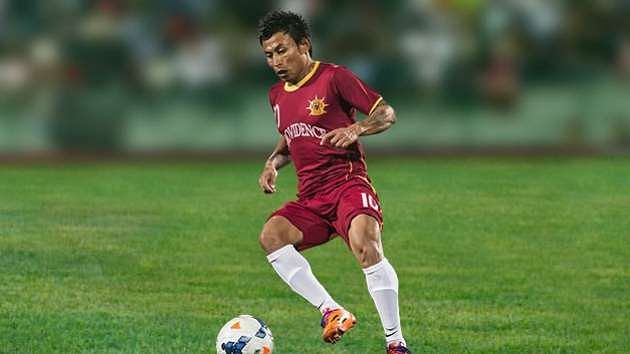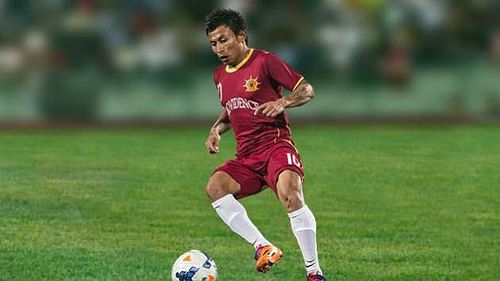
Jackichand Singh: A tea seller who never gave up
Jackichand Singh’s move to East Bengal this year may not have started on a high note, but the attacker from Manipur has been through enough hardships in life to come through his current lean phase.
Dreaming from humble beginnings
“When I started out, I played football for money because I’ve seen what poverty is.” Singh told Goalbold last year. The 25-year-old is a household name in the Indian footballing sphere today, but his was a career that kickstarted with a fair bit of struggle.
Singh was born to a poor family in a small village in Manipur. His father was a farmer while his mother used to run a tea stall. Little Singh helped his mother in her stall, and his footballing dream started from there.
“They used to stop by for tea after playing and kept the ball at the shop. After they would leave, I used to take the ball and play alone, trying to emulate the tricks.” The “they” he mentioned above are Manipuri teenagers who used to play football right next to his mother’s tea stall.
While he could not play with those teenagers, young Singh’s enthusiasm towards the sport meant he would find ways to do his own kickabouts.
It is easy to understand why Lionel Messi is one of Singh’s favourite players. Those private kickabouts and an affinity towards the ball are things you can associate with a young Messi, and those have contributed to the player Singh is today and the one he could become down the line.
That his first football boots were undersized, borrowed ones, costing only hundred rupees shows how far Singh has come in his footballing journey.
The rise of Jacki
When he arrived on the big stage of I-League football in the 2014/15 season, Singh almost instantly hit the right notes. Eight goals in his first season of top-flight Indian football contributed to his team — minnows Royal Wahingdoh from Meghalaya — finishing third in the league.
“It happened all in a year and at a brisk pace. I was so lucky, I got to play in the top division in I-League as my club Royal Wahingdoh got promoted from the second division.
“I performed well and got the ‘Best Player’ award of the I-League and was subsequently picked in the senior Indian team. Later, to get picked in the ISL 2 auction summed up my great year,” Singh explained the Deccan Chronicle in March last year after his rapid rise.
But, it hasn’t been smooth sailing for the tricky attacker since. Poverty, as he said, became a thing of the past after he came into the consciousness of the Indian footballing mainstream. The advent of the Indian Super League in 2014 also helped, as the label of India’s rising football star stuck to Singh.
“Since my childhood, we have had a lot of financial problems. I have earned a little bit by playing in the I-League, and we bought land and started building a house. But it’s not complete.
“If I get some money from the Indian Super League, then I will be able to finish the house,” Singh told The Hindu in June 2015, before stepping onto the moneyed fields of ISL football.
ISL and start of the slump
Singh has seldom hit the heady heights of his Royal Wahingdoh days. After being bought by FC Pune City for ISL 2015, performances and end products have spiralled downward for the India international.
In his first season in the Indian top flight, Singh netted eight goals in 22 appearances in all competitions for Royal Wahingdoh. He has since played for four clubs — two ISL clubs among them — in almost two years, with a meagre return of four goals in 39 matches.
Playing in the ISL may have taken away his cutting edge or made him more injury-prone, but Singh believes the short annual tournament has had a positive effect on him. From playing and training in a fully professional setup to learning new tricks of the trade, Singh termed his ISL experience after his stint with Pune City as “great”.
“ISL was a great experience. Earlier, I used to eat anything and take a lot of rice. But, we had a proper diet plan in place and learnt what to eat and drink. Playing with quality foreign players gave us the exposure.
“The pre-season training was great to start with as coach David Platt prepared us fully for his style of play, and taught us about the permutations and combinations,” he opened up on his ISL experience.
The Royal connection
However, things haven’t panned out as expected for Singh ever since Royal Wahingdoh’s withdrawal from the 2015/16 I-League. The Royals’ non-participation, coupled with Singh’s rising stock, meant the then 23-year-old outgrew his club.
While money seemed to be Singh’s driving force in his early days as a footballer, he admitted that his perspective has changed over the years.
“My perspective has changed over the years. Money is important even now but it is not the dictating factor. I share a special relationship with Royal Wahingdoh. It won’t be so easy to end it,” Singh told Goalbold.
Perhaps it is his deep ties to his former club that have contributed to his drop-off, while the impact of injuries also cannot be ignored.
What lies ahead
While Royal Wahingdoh cannot match Singh’s ambitions, the player has floundered in unfamiliar climes. He has only played 72 minutes this I-League campaign for East Bengal, not quite the stuff of headlines.
However, the way he carved his career from dreaming out of a tea stall to becoming one of the most sought-after Indian footballers, Singh, who is still one of the stars of the Indian national team, has his past to look back on for motivation.
Still only 25, Singh has a long way to go in his playing career, and the way he recovers from his latest slump in his club career will be another story of inspirational proportions.
